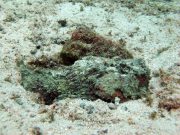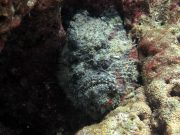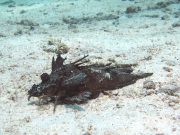Diving with Stonefishes
Lanta Marine Life | Synanceiidae
The Stonefish family Synanceiidae are slow-moving, bottom-dwelling fish that live in shallower parts of the reef among rocks and corals. On Koh Lanta diving trips, we're most likely to find Stonefish around the Lagoon at Koh Haa.
Members of this family are mostly thickset fish, with large heads and mouths, and small eyes. The body is covered in bumpy wart-like skin glands and fleshy flaps that can aid with camouflage. Sometimes algae can be seen growing on the body, further improving the camouflage.
Usually found resting on the bottom, buried in sand, or hugging a piece of dead coral, stonefish are masters of camouflage, disguising themselves as rocks and stones, blending almost exactly with their surroundings in colour and form.



Similar to their scorpionfish relatives, stonefish have very sharp, hollow dorsal fin spines, much like a hypodermic needle, each with a venomous gland located at the base.
Stonefish venom is used for self defence, with poison usually injected when an unsuspecting victim accidently leans or stands on one of these fishes. The neurotoxin venom is extremely painful.
The greyish, brownish, reddish Reef Stonefish (Synanceia verrucosa) is the most venomous fish known, and can be found at some of the dive sites around Koh Lanta, especially in and around Koh Haa Lagoon. The Reef Stonefish venom is fatal to humans.
The dark coloured Indian Ocean Walkman (Inimicus didactylus) is also found in and around Koh Haa Lagoon, and is more difficult to spot than the Reef Stonefish. Normally deeply buried in the sand, rare sightings can occur when the fish is walking along the seabed to change locations.
Indian Ocean Walkmans are also commonly known as ghoulfish, goblinfish, sea goblins, spiny devilfish, stinger, and stingfish, and are also dangerously venomous.
We don't encourage people to sit, kneel, walk, or rest on the delicate seabeds around coral reefs, not only due to the very many small and delicate creatures living on the sea bottom, but also due to the very real danger of being stung by one of nature’s most venomous fish.
Stonefish are generally solitary, feeding on small fishes and crustaceans.
2 species found on this page:
Reef Stonefish
(Synanceia verrucosa)
The Reef Stonefish, Synanceia verrucosa, is one of 36 members of the Synanceiidae family and is one of the most venomous fish in the world. This fish has a large head and tapering body, with its mouth on top of the face, and a deep depression between its eyes.

Synanceia verrucosa @ Koh Haa
Typically the Reef Stonefish reaches lengths of up to 30 - 40 centimeters and is generally grey or brown in colour, though it may also have small areas of yellow, red or orange.
The key difference between males and females is the size. The female stonefish is larger and broader around the abdomen than the male and can weigh as much as 50% more.
A carnivorous fish, the Reef Stonefish may settle around rocks and plants, or rest on the seabed and is extremely well camouflaged as rock or coral. They are difficult to find and are also known to use their large pectoral fins to bury themselves in the sand, with only the eyes and mouth visible.
The Reef Stonefish eats mostly small fish, shrimp, and other crustaceans. It usually waits for its prey to swim past, and then strikes with incredible speed. Waiting for hours at a time, stonefish strike when their potential prey is less than their body length away. Their powerful jaws and large, rapidly expanding mouths create so much pressure that they are easily able to suck down their unsuspecting prey and swallow it whole. The attack can last as little as 0.01 seconds and requires high-speed video equipment to capture.

Reef Stonefish @ Koh Haa
As a purely defensive measure, the dorsal fin comprises 13 sharp, stiff, hollow spines, each with a venom sac. When disturbed, the Reef Stonefish will typically not swim away, and will instead erect it's poisonous dorsal fin spines.
The venom is usually released when pressure is applied to the stonefish's spine, which means the poison is most often emitted when the stonefish is being attacked by a predator or stepped on by a human. Effects of the venom include severe pain, shock, paralysis and tissue death. A large dose can be fatal to humans. Predators of the Reef Stonefish include sharks and rays.

Reef Stonefish @ Koh Haa
The stonefish can survive out of water for up to 24 hours. This may be an adaptation to its shallow water existence where it may get trapped in drying out rock-pools during low tide.
In addition to the dorsal spines and venom, stonefish also possess a 'lachrymal sabre', a very sharp spine embedded in each side of the face, beneath each eye. This sharp blade can be deployed by squeezing its cheeks, which pull on the upper jaw and rotate the spines. This built-in weapon is non-venomous, however, they are extremely sharp.
The stonefish is a solitary animal. The only time it will actively seek out another is during mating season. The female stonefish releases a layer of eggs on the seafloor, with the male then releasing sperm over them.
Indian Ocean Walkman
(Inimicus didactylus)
The Indian Ocean Walkman, also known as the Spiny Devilfish, has a flattened head, large bulbous eyes and an upturned shout. The dorsal spines are highly venomous, with the first three being connected by a thin membrane. Dorsal spines may cause very painful and deep wounds, and can be fatal.

Inimicus didactylus @ Koh Haa
The Indian Ocean Walkman can quickly change colour to aid camouflage, and likes to partially bury itself in sand during the day. The fan-like pectoral fins are very colourful when opened, usually when disturbed or during courtship.

Inimicus didactylus @ Koh Haa
This species can sometimes be seen 'walking' on the seafloor using the forward pelvic fin spines which are not connected via fin membrane, and have adapted as forward 'legs'.

Inimicus didactylus @ Koh Haa
The Indian Ocean Walkman grows to 25 cm and is found in sand and rubble areas close to coral reefs. The diet includes small fishes and crustaceans.
Diving with Stonefishes around Koh Lanta
Scuba Diving & Snorkel Trips
If you'd love a chance to spot Stonefishes on one of our daily high season diving trips from Koh Lanta then send us an email to info@diveandrelax.com.
Join our high season speedboat dive trips to some of Thailand's best dive sites and enjoy small groups, short journey times, with a focus on great personal service, safety and fun.
Not yet a certified diver? Learn to Scuba Dive on Koh Lanta with the 3 day SSI Open Water Diver course.
Book online to save 10% on dive trips and scuba courses on Koh Lanta.
Find Out More
Indo-Pacific Marine Life Guides
- Allen, G., Steene, R., Humann, P., DeLoach, N. (2003) Reef Fish Identification, Tropical Pacific. Jacksonville, FL., USA: New World Publications, Inc., ISBN 1-878348-36-1.
- Humann, P., DeLoach, N., (2010) Reef Creature Identification, Tropical Pacific. Jacksonville, FL., USA: New World Publications Inc., ISBN 978-1-878348-44-9
- Debelius, H. (2013) Indian Ocean Reef Guide. Frankfurt, Germany: IKAN - Unterwasserarchiv, ISBN 978-3-939767-52-7.
- Debelius, H. (2004) Nudibranchs and Sea Snails, Indo-Pacific Field Guide. Frankfurt, Germany: IKAN - Unterwasserarchiv, ISBN 3-925919-51-1
- Erhardt, H., Knop, D. (2015) Corals Indo-Pacific Field Guide. Frankfurt, Germany: IKAN - Unterwasserarchiv, ISBN 3-925919-69-4.
- Veron J.E.N., Stafford-Smith M.G., Turak E. and DeVantier L.M. (2016). Corals of the World



